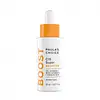What's inside
What's inside
 Key Ingredients
Key Ingredients

 Benefits
Benefits

 Concerns
Concerns

No concerns
 Ingredients Side-by-side
Ingredients Side-by-side

Squalane
EmollientTetrahexyldecyl Ascorbate
AntioxidantFragaria Ananassa Seed Oil
AntioxidantCaprylic/Capric Triglyceride
MaskingTulipa Gesneriana Flower Extract
Skin ConditioningBakuchiol
AntimicrobialNiacinamide
SmoothingCannabis Sativa Seed Oil
EmollientAstragalus Membranaceus Root Extract
EmollientSpilanthes Acmella Flower/Leaf/Stem Extract
AntimicrobialAcmella Oleracea Extract
Skin ProtectingUbiquinone
AntioxidantCeramide NP
Skin ConditioningCeramide As
Skin ConditioningCeramide AP
Skin ConditioningCeramide Ns
Skin ConditioningCholesterol
EmollientCeramide EOP
Skin ConditioningTocopherol
AntioxidantTocopheryl Acetate
AntioxidantChamomilla Recutita Flower Extract
MaskingEchinacea Purpurea Extract
MoisturisingEuterpe Oleracea Fruit Extract
Terminalia Ferdinandiana Fruit Extract
AntioxidantVaccinium Angustifolium Fruit Extract
Skin ProtectingCarica Papaya Fruit Extract
Skin ConditioningAnanas Sativus Fruit Extract
Skin ConditioningActinidia Chinensis Fruit Extract
EmollientCarthamus Tinctorius Seed Oil
MaskingCaprylyl Glycol
EmollientEthylhexylglycerin
Skin ConditioningOlea Europaea Fruit Oil
MaskingRubus Idaeus Seed Oil
EmollientCitrullus Lanatus Seed Oil
EmollientRibes Nigrum Seed Oil
EmollientPrunus Amygdalus Dulcis Oil
Skin ConditioningPersea Gratissima Oil
Skin ConditioningCaryodendron Orinocense Seed Oil
EmollientBrassica Oleracea Italica Seed Oil
EmollientRosa Canina Fruit Oil
EmollientSodium Hyaluronate
HumectantKinetin
Skin ConditioningIndole Acetic Acid
Skin ConditioningHydrogenated Lecithin
EmulsifyingDipropylene Glycol
HumectantGlyceryl Stearate
EmollientSucrose Distearate
EmollientGlycerin
HumectantMaltodextrin
AbsorbentSodium Benzoate
MaskingPotassium Sorbate
PreservativeWater
Skin ConditioningSqualane, Tetrahexyldecyl Ascorbate, Fragaria Ananassa Seed Oil, Caprylic/Capric Triglyceride, Tulipa Gesneriana Flower Extract, Bakuchiol, Niacinamide, Cannabis Sativa Seed Oil, Astragalus Membranaceus Root Extract, Spilanthes Acmella Flower/Leaf/Stem Extract, Acmella Oleracea Extract, Ubiquinone, Ceramide NP, Ceramide As, Ceramide AP, Ceramide Ns, Cholesterol, Ceramide EOP, Tocopherol, Tocopheryl Acetate, Chamomilla Recutita Flower Extract, Echinacea Purpurea Extract, Euterpe Oleracea Fruit Extract, Terminalia Ferdinandiana Fruit Extract, Vaccinium Angustifolium Fruit Extract, Carica Papaya Fruit Extract, Ananas Sativus Fruit Extract, Actinidia Chinensis Fruit Extract, Carthamus Tinctorius Seed Oil, Caprylyl Glycol, Ethylhexylglycerin, Olea Europaea Fruit Oil, Rubus Idaeus Seed Oil, Citrullus Lanatus Seed Oil, Ribes Nigrum Seed Oil, Prunus Amygdalus Dulcis Oil, Persea Gratissima Oil, Caryodendron Orinocense Seed Oil, Brassica Oleracea Italica Seed Oil, Rosa Canina Fruit Oil, Sodium Hyaluronate, Kinetin, Indole Acetic Acid, Hydrogenated Lecithin, Dipropylene Glycol, Glyceryl Stearate, Sucrose Distearate, Glycerin, Maltodextrin, Sodium Benzoate, Potassium Sorbate, Water
Water
Skin ConditioningAscorbic Acid
AntioxidantButylene Glycol
HumectantEthoxydiglycol
HumectantGlycerin
HumectantPPG-26-Buteth-26
Skin ConditioningPEG-40 Hydrogenated Castor Oil
EmulsifyingPentylene Glycol
Skin ConditioningTocopherol
AntioxidantSodium Hyaluronate
HumectantHexanoyl Dipeptide-3 Norleucine Acetate
Skin ConditioningLecithin
EmollientFerulic Acid
AntimicrobialPanthenol
Skin ConditioningBisabolol
MaskingOryza Sativa Bran Extract
Skin ConditioningPropyl Gallate
AntioxidantSodium Gluconate
Skin ConditioningSodium Hydroxide
BufferingPhenoxyethanol
PreservativeEthylhexylglycerin
Skin ConditioningWater, Ascorbic Acid, Butylene Glycol, Ethoxydiglycol, Glycerin, PPG-26-Buteth-26, PEG-40 Hydrogenated Castor Oil, Pentylene Glycol, Tocopherol, Sodium Hyaluronate, Hexanoyl Dipeptide-3 Norleucine Acetate, Lecithin, Ferulic Acid, Panthenol, Bisabolol, Oryza Sativa Bran Extract, Propyl Gallate, Sodium Gluconate, Sodium Hydroxide, Phenoxyethanol, Ethylhexylglycerin
 Reviews
Reviews

Alternatives
Ingredients Explained
These ingredients are found in both products.
Ingredients higher up in an ingredient list are typically present in a larger amount.
Ethylhexylglycerin (we can't pronounce this either) is commonly used as a preservative and skin softener. It is derived from glyceryl.
You might see Ethylhexylglycerin often paired with other preservatives such as phenoxyethanol. Ethylhexylglycerin has been found to increase the effectiveness of these other preservatives.
Glycerin is already naturally found in your skin. It helps moisturize and protect your skin.
A study from 2016 found glycerin to be more effective as a humectant than AHAs and hyaluronic acid.
As a humectant, it helps the skin stay hydrated by pulling moisture to your skin. The low molecular weight of glycerin allows it to pull moisture into the deeper layers of your skin.
Hydrated skin improves your skin barrier; Your skin barrier helps protect against irritants and bacteria.
Glycerin has also been found to have antimicrobial and antiviral properties. Due to these properties, glycerin is often used in wound and burn treatments.
In cosmetics, glycerin is usually derived from plants such as soybean or palm. However, it can also be sourced from animals, such as tallow or animal fat.
This ingredient is organic, colorless, odorless, and non-toxic.
Glycerin is the name for this ingredient in American English. British English uses Glycerol/Glycerine.
Learn more about GlycerinSodium Hyaluronate is hyaluronic acid's salt form. It is commonly derived from the sodium salt of hyaluronic acid.
Like hyaluronic acid, it is great at holding water and acts as a humectant. This makes it a great skin hydrating ingredient.
Sodium Hyaluronate is naturally occurring in our bodies and is mostly found in eye fluid and joints.
These are some other common types of Hyaluronic Acid:
Learn more about Sodium HyaluronateTocopherol (also known as Vitamin E) is a common antioxidant used to help protect the skin from free-radicals and strengthen the skin barrier. It's also fat soluble - this means our skin is great at absorbing it.
Vitamin E also helps keep your natural skin lipids healthy. Your lipid skin barrier naturally consists of lipids, ceramides, and fatty acids. Vitamin E offers extra protection for your skin’s lipid barrier, keeping your skin healthy and nourished.
Another benefit is a bit of UV protection. Vitamin E helps reduce the damage caused by UVB rays. (It should not replace your sunscreen). Combining it with Vitamin C can decrease sunburned cells and hyperpigmentation after UV exposure.
You might have noticed Vitamin E + C often paired together. This is because it is great at stabilizing Vitamin C. Using the two together helps increase the effectiveness of both ingredients.
There are often claims that Vitamin E can reduce/prevent scarring, but these claims haven't been confirmed by scientific research.
Learn more about TocopherolWater. It's the most common cosmetic ingredient of all. You'll usually see it at the top of ingredient lists, meaning that it makes up the largest part of the product.
So why is it so popular? Water most often acts as a solvent - this means that it helps dissolve other ingredients into the formulation.
You'll also recognize water as that liquid we all need to stay alive. If you see this, drink a glass of water. Stay hydrated!
Learn more about Water